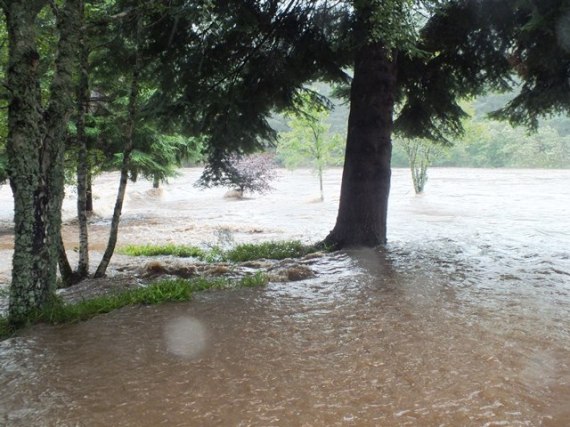Trying to assess the impact of extreme spates on our juvenile stocks is a long held ambition and something I promised to do at the Spey Fshery Board AGM two years ago. Big Bertha provided the ideal oportunity with pre event electrofishing survey data available and the low water in September providing ideal conditions for repeat surveys.

The Spey up in the trees on the 11th Aug 2014
For the monitoring strategy we decided to replicate some of the timed surveys in the Spey mainstem and River Fiddich. Eleven timed sites were repeated on the Spey and four in the lower Fiddich. The results were interesting with a statistically significant reduction in the fry counts but an increase (although not significant) in the parr counts. The three Spey mainstem sites with the largest reductions in fry counts were all in areas where the riverbed was liable to become mobilised during the peak of the spate. There was less of a change in the pre and post spate counts in more stable parts of the river.
We found evidence of downstream movement of juvenile fish, something that was particularly evident in the Fiddich where the thermal uplift from the distillery cooling water has unique effects.
The salmon fry numbers overall in the Spey survey sites after the spate were close to the average for the whole Spey in 2014 summer surveys. In the Fiddich the decline was greater although from a higher base level. The study raised as many questons as it answered. For example how many fry would we normally expect to find in September compared to the usual monitoring time of July? I would probably expect to find similar numbers in September as the bulk of the overwinter mortality probably occurs in the autumn onwards.
The perceived wisdom is that although fry numbers are lower now than they would have been if there had been no damaging spate the survival of those remaining should be better due to less competition. We hope that this will be the case although we will have to wait until next years surveys to establish that. The 2015 smolt production will almost certainly be impacted by the big spate and the subsequent fish kill but no doubt nature has its ways of compensating.
Following the Bertha spate a decison was made to stock the 50,000 lower Spey origin hatchery fish back into the lower mainstem rather than into lower river tributaries. We were able to monitor the impacts of this stocking as the stocked fish were adipose fin clipped by the Spey ghillies. The fin clipping allowed us to successfully identify the stocked fish so that their contribution could be assessed.
The results from the stocking monitoring and the post spate monitoring can be read by clicking here.
Spey Fishery Board
